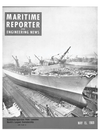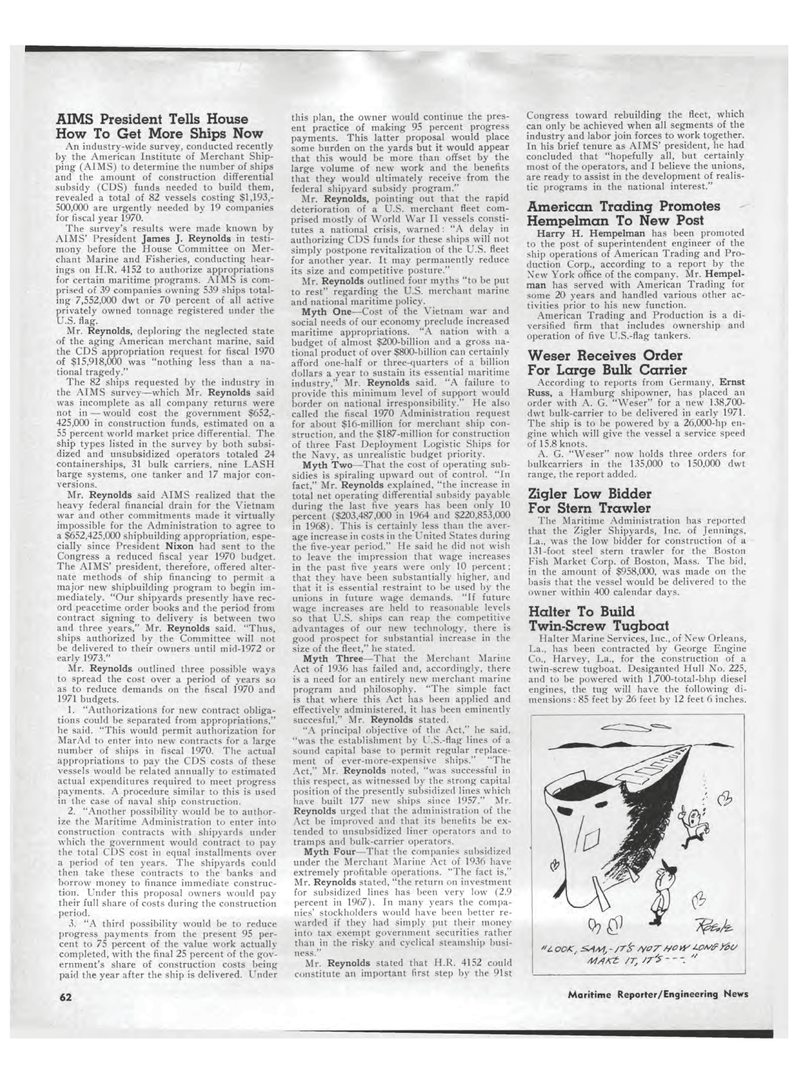
Page 58: of Maritime Reporter Magazine (May 15, 1969)
Read this page in Pdf, Flash or Html5 edition of May 15, 1969 Maritime Reporter Magazine
AIMS President Tells House How To Get More Ships Now An industry-wide survey, conducted recently by the American Institute of Merchant Ship-ping (AIMS) to determine the number of ships and the amount of construction differential subsidy (CDS) funds needed to build them, revealed a total of 82 vessels costing $1,193,-500,000 are urgently needed by 19 companies for fiscal year 1970. The survey's results were made known by AIMS' President James J. Reynolds in testi-mony before the House Committee on Mer-chant Marine and Fisheries, conducting hear-ings on H.R. 4152 to authorize appropriations for certain maritime programs. AIMS is com-prised of 39 companies owning 539 ships total-ing 7,552,000 dwt or 70 percent of all active privately owned tonnage registered under the U.S. flag. Mr. Reynolds, deploring the neglected state of the aging American merchant marine, said the CDS appropriation request for fiscal 1970 of $15,918,000 was "nothing less than a na-tional tragedy." The 82 ships requested by the industry in the AIMS survey?which Mr. Reynolds said was incomplete as all company returns were not in ? would cost the government $652,-425,000 in construction funds, estimated on a 55 percent world market price differential. The ship types listed in the survey by both subsi-dized and unsubsidized operators totaled 24 containerships, 31 bulk carriers, nine LASH barge systems, one tanker and 17 major con-versions. Mr. Reynolds said AIMS realized that the heavy federal financial drain for the Vietnam war and other commitments made it virtually impossible for the Administration to agree to a $652,425,000 shipbuilding appropriation, espe-cially since President Nixon had sent to the Congress a reduced fiscal year 1970 budget. The AIMS' president, therefore, offered alter-nate methods of ship financing to permit a major new shipbuilding program to begin im-mediately. "Our shipyards presently have rec-ord peacetime order books and the period from contract signing to delivery is between two and three years," Mr. Reynolds said. "Thus, ships authorized by the Committee will not be delivered to their owners until mid-1972 or early 1973." Mr. Reynolds outlined three possible ways to spread the cost over a period of years so as to reduce demands on the fiscal 1970 and 1971 budgets. 1. "Authorizations for new contract obliga-tions could be separated from appropriations," he said. "This would permit authorization for MarAd to enter into new contracts for a large number of ships in fiscal 1970. The actual appropriations to pay the CDS costs of these vessels would be related annually to estimated actual expenditures required to meet progress payments. A procedure similar to this is used in the case of naval ship construction. 2. "Another possibility would be to author-ize the Maritime Administration to enter into construction contracts with shipyards under which the government would contract to pay the total CDS cost in equal installments over a period of ten years. The shipyards could then take these contracts to the banks and borrow money to finance immediate construc-tion. Under this proposal owners would pay their full share of costs during the construction period. 3. "A third possibility would be to reduce progress payments from the present 95 per-cent to 75 percent of the value work actually completed, with the final 25 percent of the gov-ernment's share of construction costs being paid the year after the ship is delivered. Under this plan, the owner would continue the pres-ent practice of making 95 percent progress payments. This latter proposal would place some burden on the yards but it would appear that this would be more than offset by the large volume of new work and the benefits that they would ultimately receive from the federal shipyard subsidy program." Mr. Reynolds, pointing out that the rapid deterioration of a U.S. merchant fleet com-prised mostly of World War II vessels consti-tutes a national crisis, warned: "A delay in authorizing CDS funds for these ships will not simply postpone revitalization of the U.S. fleet for another year. It may permanently reduce its size and competitive posture." Mr. Reynolds outlined four myths "to be put to rest" regarding the U.S. merchant marine and national maritime policy. Myth One?Cost of the Vietnam war and social needs of our economy preclude increased maritime appropriations. "A nation with a budget of almost $200-billion and a gross na-tional product of over $800-billion can certainly afford one-half or three-quarters of a billion dollars a year to sustain its essential maritime industry," Mr. Reynolds said. "A failure to provide this minimum level of support would border on national irresponsibility." He also called the fiscal 1970 Administration request for about $16-million for merchant ship con-struction, and the $187-million for construction of three Fast Deployment Logistic Ships for the Navy, as unrealistic budget priority. Myth Two?That the cost of operating sub-sidies is spiraling upward out of control. "In fact," Mr. Reynolds explained, "the increase in total net operating differential subsidy payable during the last five years has been only 10 percent ($203,487,000 in 1964 and $220,853,000 in 1968). This is certainly less than the aver-age increase in costs in the United States during the five-year period." He said he did not wish to leave the impression that wage increases in the past five years were only 10 percent; that they have been substantially higher, and that it is essential restraint to be used by the unions in future wage demands. "If future wage increases are held to reasonable levels so that U.S. ships can reap the competitive advantages of our new technology, there is good prospect for substantial increase in the size of the fleet," he stated. Myth Three?That the Merchant Marine Act of 1936 has failed and, accordingly, there is a need for an entirely new merchant marine program and philosophy. "The simple fact is that where this Act has been applied and effectively administered, it has been eminently succesful," Mr. Reynolds stated. "A principal objective of the Act," he said, "was the establishment by U.S.-flag lines of a sound capital base to permit regular replace-ment of ever-more-expensive ships." "The Act," Mr. Reynolds noted, "was successful in this respect, as witnessed by the strong capital position of the presently subsidized lines which have built 177 new ships since 1957." Mr. Reynolds urged that the administration of the Act be improved and that its benefits be ex-tended to unsubsidized liner operators and to tramps and bulk-carrier operators. Myth Four?That the companies subsidized under the Merchant Marine Act of 1936 have extremely profitable operations. "The fact is," Mr. Reynolds stated, "the return on investment for subsidized lines has been very low (2.9 percent in 1967). In many years the compa-nies' stockholders would have been better re-warded if they had simply put their money into tax exempt government securities rather than in the risky and cyclical steamship busi-ness." Mr. Reynolds stated that H.R. 4152 could constitute an important first step by the 91st Congress toward rebuilding the fleet, which can only be achieved when all segments of the industry and labor join forces to work together. In his brief tenure as AIMS' president, he had concluded that "hopefully all, but certainly most of the operators, and I believe the unions, are ready to assist in the development of realis-tic programs in the national interest." American Trading Promotes Hempelman To New Post Harry H. Hempelman has been promoted to the post of superintendent engineer of the ship operations of American Trading and Pro-duction Corp., according to a report by the New York office of the company. Mr. Hempel-man has served with American Trading for some 20 years and handled various other ac-tivities prior to his new function. American Trading and Production is a di-versified firm that includes ownership and operation of five U.S.-flag tankers. Weser Receives Order For Large Bulk Carrier According to reports from Germany, Ernst Russ, a Hamburg shipowner, has placed an order with A. G. "Weser" for a new 138,700-dwt bulk-carrier to be delivered in early 1971. The ship is to be powered by a 26,000-hp en-gine which will give the vessel a service speed of 15.8 knots. A. G. "Weser" now holds three orders for bulkcarriers in the 135,000 to 150,000 dwt range,the report added. Zigler Low Bidder For Stern Trawler The Maritime Administration has reported that the Zigler Shipyards, Inc. of Jennings, La., was the low bidder for construction of a 131-foot steel stern trawler for the Boston Fish Market Corp. of Boston, Mass. The bid, in the amount of $958,000, was made on the basis that the vessel would be delivered to the owner within 400 calendar days. Halter To Build Twin-Screw Tugboat Halter Marine Services, Inc., of New Orleans, La., has been contracted by George Engine Co., Harvey, La., for the construction of a twin-screw tugboat. Desiganted Hull No. 225, and to be powered with 1,700-total-bhp diesel engines, the tug will have the following di-mensions : 85 feet by 26 feet by 12 feet 6 inches. "t OOKj -/T'S WOT HOW t-ovftec; /VMKt /Tj - ~ " " 62 Maritime Reporter/Engineering News

 57
57

 59
59
